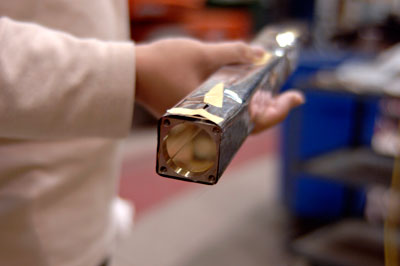
The new calorimeter, called BigCal, contained 1,744 lead glass bars, such as the one shown, for detecting the scattered electrons.
A collaboration of scientists is probing deep inside the proton at Jefferson Lab by measuring quantities that relate to the proton's shape and size. These so-called form factors give scientists a tool for studying the proton's inner structure.
"In principle, we would like to know these form factors to characterize the proton," says Vina Punjabi, a professor at Norfolk State University and an experiment co-spokesperson. "To know everything about protons and neutrons, that's the goal,"
Form factors describe the shape and size of the space over which the electric charge and electric current is spread in the proton. The proton gets its charge from its building blocks: quarks. There are three quarks inside the proton, two "up" quarks and one "down" quark. Up quarks carry a positive charge, while the down quark is negative.
The electric charge form factor, GEp, is connected to the electric field generated by the electric charges of the quarks.
"The electric form factor must be positive in the proton as a whole. But there is a negative charge in there from the down quark," explains Charles Perdrisat, a professor at The College of William & Mary and an experiment co-spokesperson.
As the charged quarks move around, they generate an electric current, which creates a magnetic field. The magnetic form factor, GMp, is therefore related to the quarks' movement.
The experiment set out to measure the ratio of the two form factors: GEp/GMp.
Twelve years ago, the first experiments at JLab to probe the proton with polarized electrons measured the ratio of these two form factors. Previously, it had been thought that this ratio was constant. But the JLab experiment found that the electric charge form factor decreases significantly faster than the magnetic form factor.
"Before this experiment, we thought that we knew all about protons. But we really didn't," Punjabi says.
A follow-up experiment confirmed this result and extended the ratio even further. Now, the scientists want to see how the ratio evolves as they push yet deeper into the proton.
The Experiment

The experiment was conducted in JLab's Experimental Hall C. A new focal plane polarimeter was installed in Hall C's High Momentum Spectrometer (top left) to measure the spin of the struck protons.
The experiment ran in Hall C in the spring of 2008. In it, the proton was probed with high-energy electrons from Jefferson Lab's CEBAF accelerator. These electrons plow deep into the proton to probe the quarks inside. The angle at which they leave the proton is then measured, determining the so-called momentum transfer.
What the probing electrons ‘see’ when they collide with a proton is complex but depends on the violence of the interaction. For modestly violent collisions, i.e. small momentum transfers, the electrons ‘see’ the overall size and shape of the proton.
As the violence, or momentum transfer, increases, the region of internal space probed becomes smaller. Eventually, the electron starts to interact with individual quarks, rather than the proton as a whole. The momentum transfer was about three times as large as in the original CEBAF experiment. "You are basically reaching to smaller and smaller regions," Perdrisat says.
Two new detectors were installed in Hall C to detect the scattered electrons and the struck protons. A new lead-glass calorimeter, called BigCal, detected the electrons, and a new focal plane polarimeter was installed in Hall C's High Momentum Spectrometer to measure the spin of the struck protons.
The Result
The first result from the experiment was recently published in the journal Physical Review Letters. The new, high-precision measurement of the proton form factor ratio reached the smallest value of this ratio observed so far anywhere - 50 percent smaller than in previous measurements. These data delivered a surprising twist.
"Things didn't quite go the way we expected. The dramatic decrease in the electric charge versus the magnetic form factor that we found earlier shows indications of slowing down," Perdrisat says "We expected the straight line to continue, but it does not continue."
This slowing down could indicate that the violence of the interaction, the momentum transfer, is approaching the region in which the electron probe is beginning to “see” the individual quarks in the proton: a transition from probing the proton as a whole to studying its quarks.
In addition, the researchers suspect that they are seeing a special circumstance of how the electron probe is interacting with the proton and its quarks. Even though the electron is carrying enough energy to shatter the proton, the experimenters are detecting intact protons that the electron has interacted with.
The electron seems to be giving up most of its energy in the form of momentum to one of the proton's quarks, which then passes part of it on to the other quarks in the proton.
"The momentum is shared among the three quarks, so that they stick together like they were in the proton," Perdrisat explains. "You are bringing in a huge amount of momentum, so it has to be spread in just the right way."
Moving Forward
Now the experimenters are looking forward to their next experiment, which will use electrons with even higher energies. "We want to go deeper," Punjabi asserts.
The goal is to see the very finest details of the proton's hidden inner structure.

